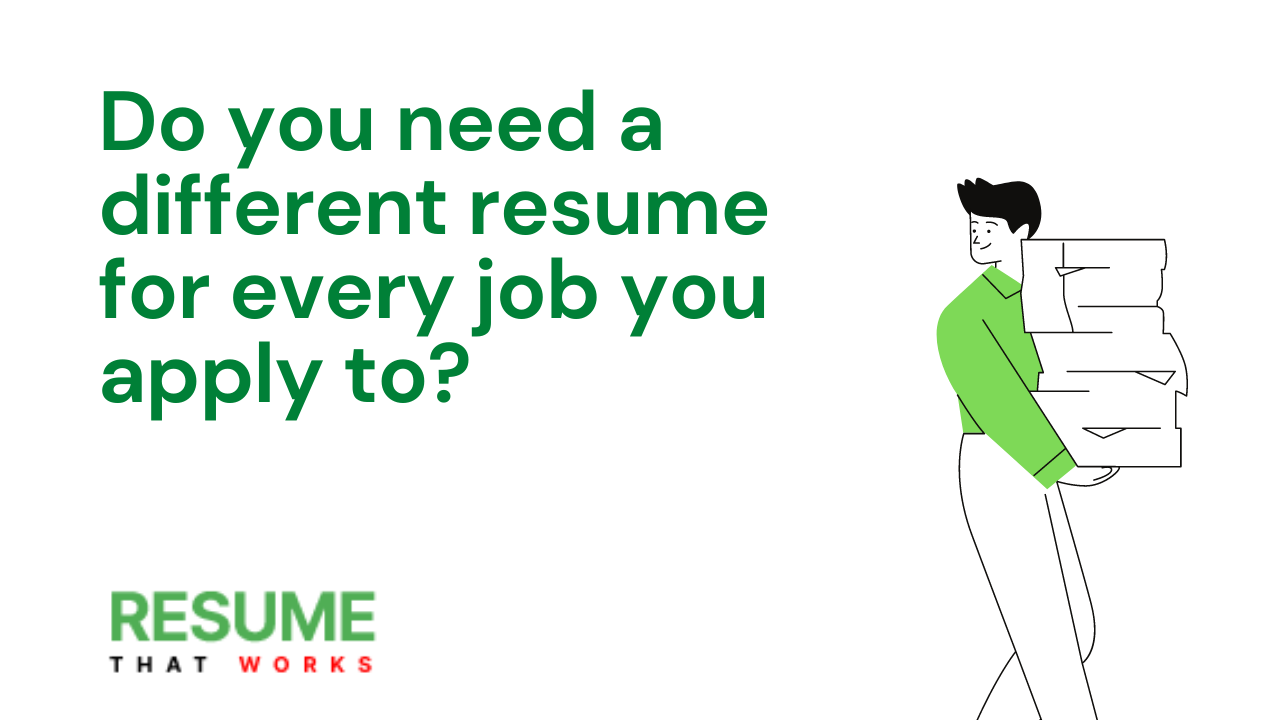We understand how our spirits get dashed when we send out job applications to multiple organizations and find our inboxes empty. If you are one of those who do not get any callbacks, you need to ask yourself, “have I ever customized my resume for the same position at different companies?”
Often job-searchers have this misconception that a job application is all about their education, job history, and accomplishments. No doubt, your resume is the best tool for communicating your career history, but you should always understand the requirements of an employer. Job positions might be similar, but every employer has a set of requirements and eligibility criteria. Therefore, you must customize your resume for each position you apply to.
Customizing your resume for each job might sound time-consuming, but you’ll soon find it easier when using specific tactics. Pick cues from the job description and put a little more effort into formatting the resume. Such extra efforts go a long way, and the hiring manager notices your interest in a job position.
Why tailoring your resume is necessary?
People often ask if they should customize their resume every time they apply for a job. Is it necessary to have different resumes for different jobs? The answer to these questions is yes! Tailor your resume for every job so that your resume demonstrates your suitability for the respective company, not for some other employer. You don’t need to treat your resume as a formality. You better take it as a personal marketing tool to showcase your skills and abilities. This approach will lead you to great job opportunities and career advancements.
If you customize your resume according to the job description, it will be easier for the employer to see how well-suited and valuable a candidate you are. You can add details relevant to the company’s needs. A customized resume looks much more professional than a bland document; containing out-of-place information for the hiring manager.
The logic is clear and simple; different employers have different requirements, values, and objectives. Therefore, customization is necessary to highlight how you are most suitable for the role. There’s no point in applying for a position half-heartedly. You may focus on developing professional relationships. Therefore, make your first impression remarkable.
Put in an extra effort to impress the employer
Until you put extra effort into your job application, you won’t be able to impress your employer. There are certain hiring practices that you need to be aware of. Hiring managers receive hundreds of resumes every day, and many employers can differentiate between copy-pasted and well-written documents. They are looking for candidates who fit best with their job description. They can see through resumes who show interest in the role being offered. So, the job-seekers who’ve given few job interviews know how to impress their employers.
A tailored resume conveys your interest and excitement about joining the company and convinces the hiring manager that you are an excellent option. Adding relevant references gives an impression that the resume is specifically crafted for the employer.
Customizing your resume for each job position
You personalize, customize and align your resume for the job application according to the qualifications and requirements mentioned in the job description. Highlight relevant skills, achievements, and milestones carefully selected from your career history. For example, you might consider putting a heading on top of your resume saying “Seeking (Job Title) at (Company). This way, you can directly address the employer.
You go in a subtle manner if you want. You may want to add more details under the work experience heading. Highlight relevant job experience and briefly describe the skills you learned there that might be helpful in the job position you’re aiming for. For instance, Coordinated with multiple clients to complete 10+ projects within six months. These projects taught me valuable skills in time management and project management which I believe would be beneficial while working at Garrison Group of Industries.
Advantages of writing a customized resume
Writing a resume half-heartedly won’t benefit you in any way. Your resume demands your time and attention. Sending out a non-customized resume among hundreds of other job applications is just like passing outdated information to all potential employers.
One of the benefits of customizing your resume for every job opening is that you’ll be giving it a once-over at least twice a month. Here is why customizing a resume is vital every time you apply for a job:
1. Frequent reviewing of your resume.
Consistently review and update your resume. Every freelance project, volunteer role, certification, technical skill learning, and new course acquiring would allow you to strengthen your resume. Adding new skills and removing less impressive information from the resume should be frequent in every job seeker’s life.
And never forget your digital presence. Whenever you add or subtract something from your resume, update your LinkedIn profile too.
2. Remove unnecessary information.
There is a process called downward resume creep. According to this process, you keep adding new information at the top without removing anything from the bottom. It creates a pile of old and unnecessary information.
If you go through your resume now and then, you will notice sections that do not fit anymore. Some individuals are stuck on questions like “how to include similar job roles in a resume?” The answer is simple. Nobody wants repetitive information. Try removing monotonous and unwanted details from your resume because employers’ hiring practices change over time.
3. Mistakes – Everybody makes a few.
Unless you’re an experienced content writer, there must be at least one typo mistake in your resume. Maybe it’s a spelling mistake or a grammatical error. But, reading your resume, again and again, will help you identify and rectify these mistakes. Even if you have a perfectly spelled resume, free of any grammatical errors, reviewing it will help you squeeze in information to make space for more. You can use action verbs to communicate lengthier details in shorter phrases.
Use a template for customizing your resume.
Adding or subtracting details from a resume is not a hectic task. But customizing the format and template of a resume does not sound great. For instance, if someone wants to apply to 50+ jobs every month, creating a resume from scratch won’t be feasible for everyone. Of course, you don’t need to design it every time. However, don’t forget the well-known saying, “looking for employment is full-time employment.”
We have good news for you. You don’t need to spend hours developing a resume. We have good news for you. You don’t need to spend hours developing a resume. Look for reasonable templates that you can utilize whenever required. With a template, you can create a resume in around ten minutes.
How to customize a resume when you’re planning a career change?
When you’re planning to change your career, the old version of your resume won’t work at all. While making a pivot, a customized resume demonstrates your interest in learning new skills. Follow these tips on how to write a resume for a job in a different field.
1. Highlight interdisciplinary skills.
Interdisciplinary skills are the ones you can use in multiple fields. Highlight the skills you learned from your previous job that you can apply to the one you’re applying to. For instance, you might have never served as a customer representative, But, your experience as a receptionist has taught you how to effectively communicate, multitask, organize and answer and ask the right questions. Highlighting the skills, you can utilize between the two opposite jobs can demonstrate your capabilities to succeed in the new role.
2. Focus on your strengths
Do not underestimate yourself while comparing your skills with the more experienced candidates. Focus on your soft skills like customer handling, problem-solving skills, patience, and attention to detail. Your soft skills show the employer that you have the right personality and character for the position, even if you have zero experience in the field. When changing a career, it is also beneficial to highlight skills that you learned quickly, or when you resolved a matter on your own. Such instances demonstrate that you’re a quick learner and a problem-solver.
3. Mention relevant courses and certifications
After mentioning every positive trait and transferrable skill you can, you might think something is still missing that can give you a setback. To overcome this problem, you need to provide technical certification for the skill. If you already have a degree or diploma in the relevant field, it’s good to go in the resume. But if you don’t have it, enroll yourself in a related technical certification or course online. You can mention your enrollment in the program to show the employer how committed and interested you are in the job position.
The Takeaway
In conclusion, you must have different resumes for different jobs. You must highlight your job history and skill set that makes you look suitable for the new role. To get a professionally written resume, hire resume writing services. They have writing experts who know how to make your resume look the best.




